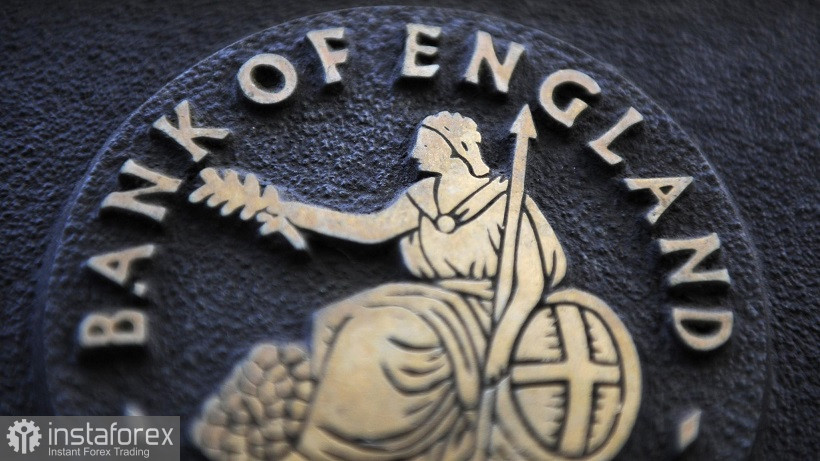The pound against the dollar is trading in a 100-point range this week, the boundaries of which are marked at 1.2150–1.2250. Yesterday, against the backdrop of the events in Taiwan, the pound had to yield the initiative to the dollar. But at the same time, the pair did not leave the above price range. And after the worst geopolitical scenarios did not materialize, GBP/USD buyers picked up the banner again, returning to the area of the 22nd figure. However, it is unlikely that another surge of buying activity will provoke an upward breakthrough to the borders of the 23rd price level. In anticipation of tomorrow's events, traders are likely to behave quite cautiously.
On Thursday, the Bank of England will sum up the results of its August meeting. Most experts are confident that tomorrow the regulator will increase the interest rate by another 50 basis points, thereby raising it to 1.75%. There are indeed many indirect and explicit factors in favor of this scenario.

Even at the last meeting, some representatives of the Central Bank advocated a more aggressive pace of tightening monetary policy. Immediately three (out of nine) members of the Committee (Michael Saunders, Catherine Mann, and Jonathan Haskel) voted in favor of raising the rate by 50 basis points. But their colleagues did not dare to support the "hawk wing" of the Central Bank, and as a result, the regulator was satisfied with a 25-point increase.
At the moment, the situation is completely different. Both macroeconomic reports and yesterday's Central Bank centrists favor implementing the 50-point scenario.
First, it is necessary to recall that, according to the latest data, the British economy showed growth despite the pessimistic forecasts for a recession. This is perhaps the key argument in favor of raising the interest rate by 50 points at once. Earlier, Bank of England Governor Andrew Bailey made it clear that the regulator had two main ways: either to raise the rate further, fighting inflationary growth (but at the same time pushing the economy into recession), or to come to terms with a further increase in the consumer price index, abandoning aggressive measures and hoping for an increase in GDP, or at least stagnation.
However, the latest report on the growth of the UK economy allows the regulator to act much more boldly. Thus, the gross domestic product rose by 0.5% in May after falling by 0.2% in April. At the same time, most analysts predicted a decline in this indicator in the negative area, to the level of -0.2%. In quarterly terms, growth to 0.4% was also recorded, while experts expected to see this component in May at a zero level. On an annualized basis, the volume of GDP increased by 3.5% (forecast - 2.7%).
The growth of the British economy was recorded against the backdrop of another jump in inflation. The overall consumer price index in June rose to 0.8% on a monthly basis. In annual terms, the index also surprised traders, rising to 9.4%. This is a long-term record—the last time this figure was at the designated height 40 years ago—in February 1982.
Against the background of these releases, the rhetoric of the representatives of the Bank of England became noticeably tougher. Including Bailey, who recently announced that the option of a 50-point rate hike "will be one of the scenarios discussed at the August meeting." BoE Cheif Economist Huw Pill made a more hawkish statement earlier, saying he was ready to support "a faster pace of policy tightening, if necessary." His colleague, Catherine Mann, also added fuel to the fire. According to Mann, uncertainty about the inflationary process "strengthens the arguments in favor of an early increase in interest rates."
As a result, most experts are confident that only one member of the Committee, Silvana Tenreyro, can vote against a 50-point increase.
Considering the fact that the above scenario is a base case and widely expected, its implementation may have a short-term impact on the GBP/USD pair. Therefore, special attention of traders will be riveted to the accompanying statement of the Central Bank, as well as Bailey's rhetoric. According to general market expectations, the Bank of England will raise interest rates by another 50 basis points in the coming months, ending the year at 2.25%. The head of the Central Bank is unlikely to specify the intentions of the regulator. However, he can voice clear messages about the further pace of tightening monetary policy.
From a technical point of view, the GBP/USD pair on the daily chart is between the middle and upper lines of the Bollinger Bands indicator. Also, on this timeframe, the price is above the Tenkan-sen and Kijun-sen lines, which are under the Kumo cloud, thus forming a Golden Cross signal, which signals an increased probability of a trend change from downside to upside. On the downside, it is advisable to consider longs with a target of 1.2250—this is the lower boundary of the Kumo cloud on D1.





















